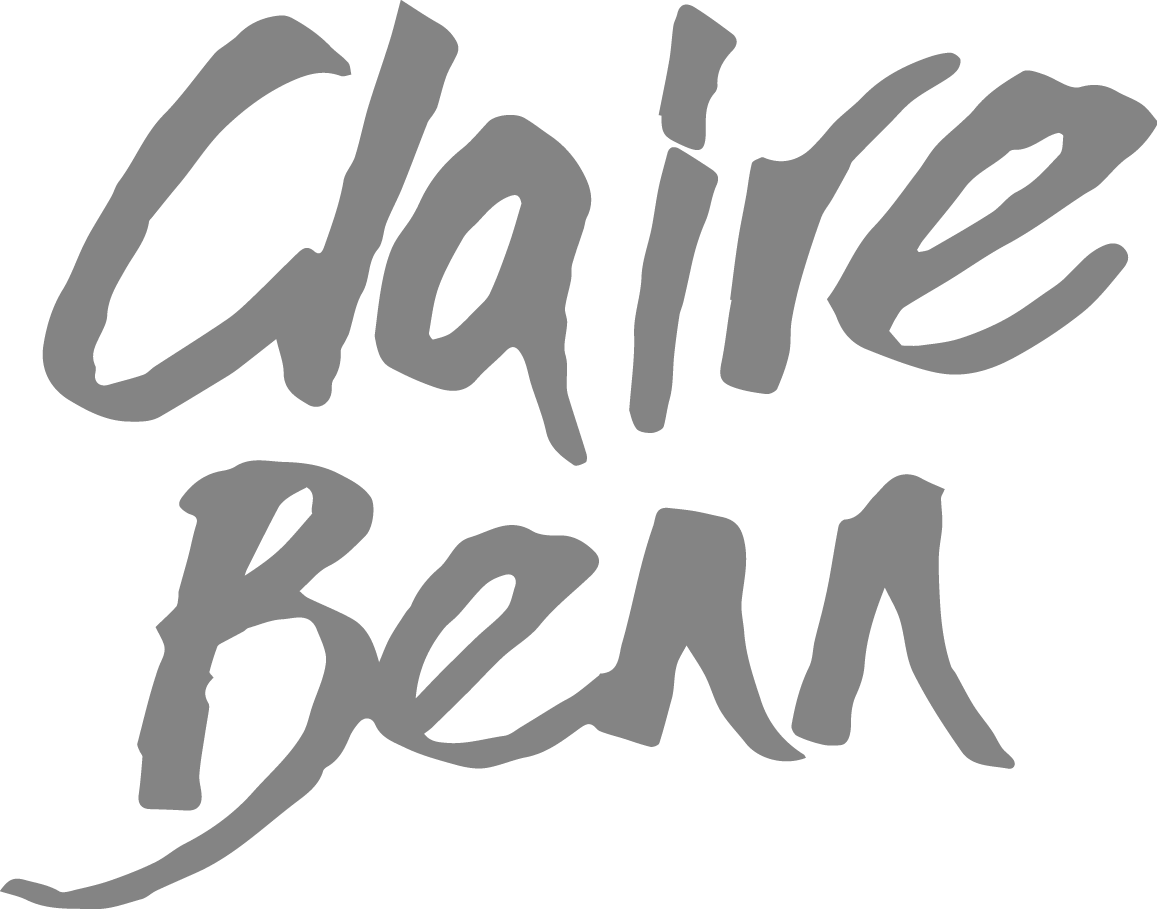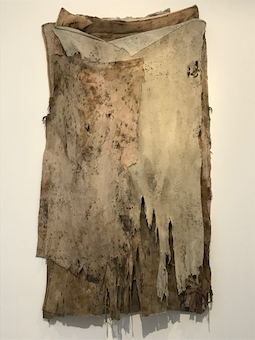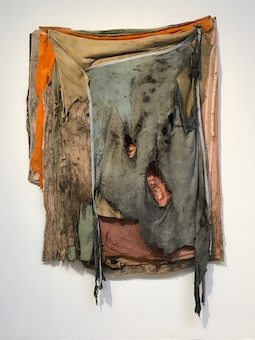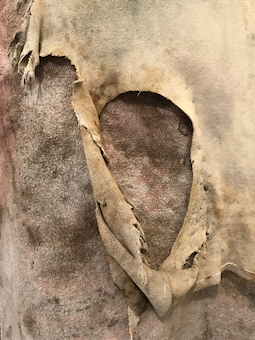Lost in Translation
Berlinda De Bruyckere at Hauser & Wirth, Somerset
In early December last year I was at the Hauser & Wirth gallery in Bruton, Somerset. My mother lives in Frome and H&W is a favourite visiting spot; great exhibitions, a superb Piet Oudolf garden, delicious food and a stimulating bookshop. What’s not to like? As we visit often I never check what’s on, preferring to be surprised. This time, walking in to the gallery space was a real treat as I was confronted with works made from textiles (and in a later gallery space, animal skins). I quickly lost myself in the individual pieces, all made from second-hand blankets left outside to weather, wear and in some areas, decompose.
The wall hung works (as opposed to the sculptural, animal skin derived forms) were composed from layers of these distressed blankets, with tatty and ragged edges dangling and holes and tears exploited. The colours were muted and faded although the artist also used accents of brighter colour, which drew the eye. Strange bulges hinted at something beneath - perhaps a body – so shrouds came to mind and for me, homelessness.
Having spent some considerable time simply looking, I wandered out to the hall in search of information on who the artist was; Berlinda De Bruyckere, a Belgian artist. When visiting exhibitions I rarely read up in advance, preferring to encounter the work and first experience my own responses. In this spirit, I chose not to read the ‘blurb’, but went back inside for another look.
Each gallery at Hauser & Wirth has a steward, and before leaving, I commented how happy I was to see textiles exhibited at Hauser & Wirth, and how I wished the medium of textiles was more readily embraced in the world of fine art. The steward responded with, “well, conceptually these works are very deep and for textiles to make it as fine art, the concept has to be very, very deep indeed”.
‘Bullshit’ (in the style of ‘Taureua’, by Picasso)
Now, I’m the first to admit I can get a bit feisty around this kind of talk and I accept that my reactions are mine alone, but my knee-jerk thought was “the implication here is that when the medium is textiles, the concept has to be deeper than other types of art. Who says?” I left, preferring not to get involved in a heated debate with someone who potentially had no idea what she was talking about. And anyway, Mum was ready to eat and I was ready for a stiff drink.
However, that short interaction stuck with me and led me to thinking about concept. It seems that recently, concept is what art is all about, but what is concept? Surely it’s simply an idea, a jumping off point or to use the words of Agnes Martin, “an inspiration”? And so I looked it up..,
Source: Oxford English Dictionary
All straightforward and understandable definitions, and common to all artists. But, it seems to me that sometimes (even often), concept can become the be-all and end-all of an artwork or body of works. This is the moment when I wonder if we become lost in the translation of the work and potentially lose touch with the visual experience it offers us. And surely, visual engagement – in whatever form that takes – has to be the (at least initial) driving force behind any artwork? To walk into a gallery and be stimulated at a visceral level - to have the ‘inward feeling rather than conscious reasoning’ - must be hugely important to most of us. Sometimes those inward feelings are positive; that pow!, that surge of spirit, that clenching of the heart, that rising of the small hairs, that yearning, that sense of peace, that getting lost in the work. Sometimes the inward feelings are negative in that we feel threatened, angry, depressed, helpless, confused, belligerent, saddened. Whatever we feel we must acknowledge we are being stimulated, we are feeling and we are responding.
In ‘ Agnes Martin – Writings’ (a small booklet by Hatje Cantz), Martin says “ The function of art work is the stimulation of sensibilities, the renewal of memories of moments of perfection.” A great viewpoint as perfection varies from person to person, and so each of us has our own individual response to a work of art.
I’m not saying I don’t want to know or try to understand what the artist’s inspiration is. What I want is to experience it personally and in my own way – I want my sensibilities stimulated without needing to think about things - that can come later - as and when I choose. And when I do read about the inspiration behind the work and think about it, I still feel that my own response is more important than the artist’s inspiration. It doesn’t really matter if I don’t ‘get it’ or don’t understand, as long as I have an authentic response. Again, Martin writes; “ People get what they need from a painting… the observer makes the painting.” And, when I do read the catalogue essays or exhibition reviews, I don’t want to be confronted by a load of ‘art-speak’ or pretentious twaddle.
Twaddle: defined as ‘useless, senseless or dull writing’
Where did this art-speak come from? What are the writers trying to prove? For me, it smacks of élitism or a desire to elevate art into a lofty atmosphere out of reach of ordinary folk. Grayson Perry is an artist I love partly because of the work, but also because of his ability to talk about his work and inspiration in language that makes sense to both an art critic and a twelve year-old. Let’s have more of that from the critics, writers and curators please.
And finally, what about beauty, plain and simple? Isn’t it enough to be in the presence of something beautiful, visually stunning, and revel in it? The natural world will often stop us in our tracks and we stand enraptured. We don’t care about the causes (why is the sky red when the sun goes down? What causes hoar frost?), we just enjoy the result.
Every day I look at a hand-tinted print by Howard Hodgkin called ‘Sundown’, and I’m pretty sure there’s no ‘deep’ concept behind it, simply a memory of the many Mumbai sunsets he liked to observe.
A five-year old girl visited recently and declared it her favourite piece of art in the house. We discussed it and when I asked what she thought the painting was about, or of, she immediately replied “a sunset”. And when I asked her why she liked it, she said “the colours make me feel happy”.
And so I urge you to simply enjoy the art that stimulates your sensibilities. Revel in your reactions, feelings and thoughts, abandon yourself to the work and lose yourself in it without feeling the need to understand why. Understand the idea or inspiration later if you want to and if you don’t, I’m sure many artists wouldn’t give a hoot, as long as you’ve been stimulated
Happy New Year. May 2019 bring inspiration, action and results. I have no idea what I’ll be writing about in February, but no doubt it’ll come to me!
P.S. Don’t get me wrong, I found Berlinda De Bryckere’s work to be excellent, and the Hauser & Wirth ‘blurb’ wasn’t twaddle!









